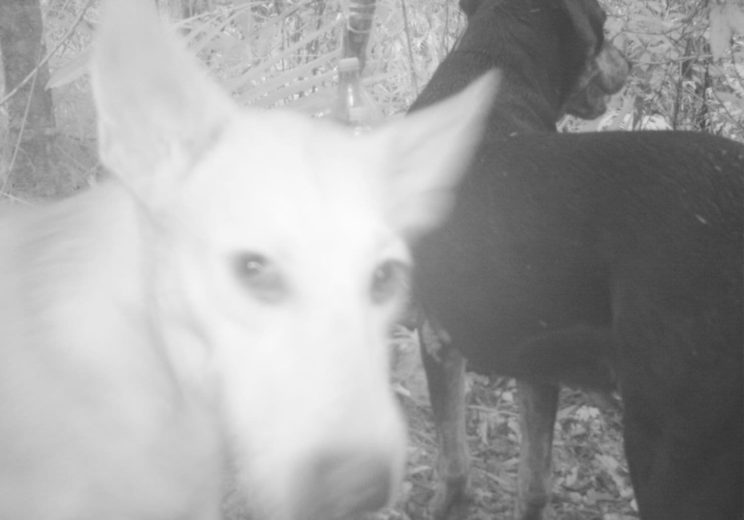First they came for the cats, now they are coming for the dogs.

There was a time when the environmental movement’s mission was to protect plants and animals from poisons, chainsaws, traps, and guns. Since it has been hijacked by Invasion Biology, an ecologically jingoistic philosophy masquerading as science, it has turned that mission on its head. It now uses poisons, chainsaws, traps, and guns to kill plants and animals. In San Francisco, the local chapter of the Sierra Club is leading the charge to clear cut remaining forests because they claim the trees are “non-native.” And to get the job done, they have jumped in bed with large scale industrial polluters, like Monsanto and Dow Chemical. In Australia, their so-called “environmentalist” counterparts are engaging in the most vile cruelty against cats, such as gutting moms and then extracting and decapitating kittens (with The New York Times acting as cheerleader). In New Zealand, they are aerial dropping volatile poisons that kill indiscriminately. And in the U.S., they use similar poisons, causing anywhere from four to seven days of suffering before animals finally succumb to internal bleeding. This long sickness period often includes abnormal breathing, diarrhea, shivering and trembling, external bleeding and spasms; suffering and death that is perpetuated when their dead bodies are ingested by subsequent animals. Conservation now means nothing more than killing.
One of the primary targets for “conservationists” has long been the cat, with Australia announcing and implementing plans to kill 2,000,000 of them. Now, the “environmental movement” is grooming us for a campaign to eradicate dogs worldwide. This time, acting as cheerleader-in-chief, is the Washington Post. A recent article in the Post calls dogs “the world’s most harmful invasive mammalian predators,” despite the fact that humans, who are “non-native” to every continent but one, are responsible for altering the planet’s climate, imperiling every species on Earth, including our own. (In fact, some studies say that many of the world’s species are on the move to survive a changing climate because if they stay, they will die. But if they move, they are labeled “non-native” by Invasion Biologists and killed. We’ve created a “no win” scenario.)
Ignoring the inequity, the article accuses dogs of the usual string cite litany of harms such as “spreading diseases” and “disrupting natural environments.” But since they are thin on the details and given that they admit “It’s a difficult thing for people to hear, [because] They love dogs too much,” they gin up complaints with such wild claims as accusing dogs of [hold on to your hats here] “goosing scientists who set up elaborate camera systems to photograph wild animals, only to come away with pictures of curious canines.”
The dogs sniff the cameras.
And for that, say ecological xenophobes, they deserve death.
Aside from the obvious absurdity, the grotesque violence, and the inversion of environmental priorities, there is the rampant hypocrisy. Nativists do not hold their own actions to the same standards which they impose upon dogs (and cats): they do not force themselves to live exclusively indoors, they do not pack up and move back to the continent where humans first evolved, and they do not stop killing and eating other creatures.
Moreover, “non-native” and “invasive species” are terms that have entered the lexicon of popular culture and become pejorative, inspiring unwarranted fear, knee-jerk suspicion, and a lack of thoughtfulness and moral consideration. They are language of intolerance, based on an idea most of us have rejected in our treatment of our fellow human beings — that the value of a living being can be reduced merely to its place of ancestral origin.
We need a kinder, more tolerant, and saner vision of environmentalism. We need one grounded in individual rights. And we need one more firmly grounded in science. Each species on Earth, writes Professor Ken Thompson,
has a characteristic distribution on the Earth’s land surface: But in every case, that distribution is in practice a single frame from a very long movie. Run the clock back only 10,000 years, less than a blink of an eye in geological time, and nearly all of those distributions would be different, in many cases very different. Go back only 10 million years, still a tiny fraction of the history of life on Earth, and any comparison with present-day distributions becomes impossible, since most of the species themselves would no longer be the same.
This never-ending transformation — of landscape, of climate, of plants and animals — has occurred, and continues to occur, all over the world, resulting from a variety of factors: global weather patterns, plate tectonics, evolution, natural selection, migration, and even the devastating effects of impacting asteroids. The geographic and fossil records tell us that there is but one constant to life on Earth, and that is change. So under what pretense does an arbitrarily picked “single frame from a very long movie” chosen by people who refuse to practice what they preach trump the right of dogs to live wherever they may be?
I’ve said it before, but it is worth repeating: “On a tiny planet surrounded by the infinite emptiness of space, in a universe in which life is so exceedingly rare as to render every blade of grass, every insect that crawls, and every animal that walks the Earth an exquisite, wondrous rarity, it is breathtakingly myopic, arrogant, and quite simply inaccurate to label any living thing found anywhere on the planet which gave it life as ‘alien’ or ‘non-native.’ There is simply no such thing as an ‘invasive’ species.”
————-
Have a comment? Join the discussion by clicking here.